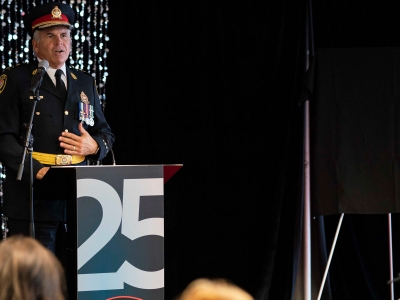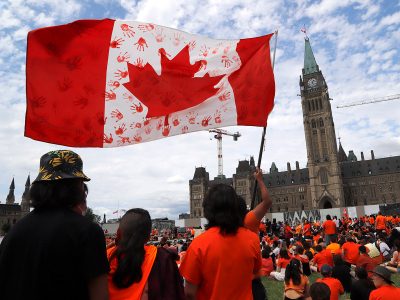By Joseph Mathieu
Photos by Chris Roussakis
Reconciliation between Indigenous and settler Canadians won’t be a restoration of friendly relations; rather, think of it as making one set of beliefs compatible with another.
“Because in Canada, since contact, it hasn’t been friendly,” said Waneek Horn-Miller. “It’s been conflict. We have to accept and acknowledge that.”
Striking common ground is what married couples have to do every day, said the Mohawk Olympian and motivational speaker.
To achieve reconciliation on a national level—across the values of settler, Indigenous and immigrant cultures—is much more complicated. The creation of a multicultural society is an ongoing experiment.
“To be perfectly honest, we’re trying to do something in Canada that has never existed on this planet,” she said. “That’s terrifying, but it’s also extraordinarily inspirational.”
Horn-Miller delivered the annual Scholars at Risk (SAR) keynote lecture on Sept. 27, 2019 to share her insight into human rights advocacy and activism.
The SAR program supports academics who are at risk in their home countries and offers them a unique opportunity to teach and interact with colleagues and students in safe environments.
“Waneek Horn-Miller has spent her life blending her activism with her professional aspirations,” said History Prof. Andrew Johnston.
“It is hard to imagine anyone who better embodies the power of advocacy,”
Horn-Miller is a Bear Clan woman of the Mohawk Nation. Originally from Kahnawake, Quebec, she is a Carleton University alumna (BA/00) and former Ravens water polo star. She went on to co-captain the first Canadian women’s Olympic water polo team at the 2000 Sydney Olympic Games and won several gold medals at the Pan American Games.
She is the first Mohawk woman to compete at the Olympics and, on Oct. 23, she will be the first water polo athlete inducted into Canada’s Sports Hall of Fame.
High-achieving athletes tend to look back on obstacles that defined their journeys, she said. Hers was the Oka crisis.
On July 11, 1990, the Mohawk bands of Kanesatake and Kahnawake began a protest over a golf course that would have expanded onto their burial grounds. By the blockade’s conclusion, Canadian Armed Forces soldiers and Mohawk warriors had faced off for 78 days. The tense situation—depicted in the famous photo of a masked Mohawk warrior staring down a Canadian soldier—was front-page news around the world.
“I saw things that summer I never thought I would see,” said Horn-Miller.
“I saw the strength, power and leadership of many women and I saw our men standing up. I saw many people across the country awakening to what it meant to fight for their rights.”
But she also saw Mohawks burned in effigy and rocks thrown at her community while police did nothing. On the last day, she was stabbed in the chest by a soldier’s bayonet as the blockade ended. A picture Horn-Miller falling backwards, holding her baby sister and screaming as she tries to keep a solider away, is another iconic photo from the crisis.
Struck by panic and anxiety attacks, the 14-year-old Waneek decided to hide away, to stay safe in her room.
Her mother Kahn-Tineta Horn had been an Indigenous rights activist since the 1960s. In January 1969, Horn was part of a blockade of the international highway between Cornwall, Ont., and the United States that passed through the Mohawk Nation of Akwesasne. She once travelled to the United Kingdom to tell Queen Elizabeth II that she had claimed Britain as a colony of the Mohawk Nation.
Horn taught her four daughters perseverance, respect and achievement. In 1990, she reminded Waneek that she was a talented athlete who had hoped to go to the Olympics.
“My dream, my advocacy and my activism started with my mother,” said Horn-Miller. “She said: ‘If you give up now, you will forever be that soldier’s victim.'”
Ten years after Oka, Horn-Miller played the best game of her career. As the Canadian team tied with the Americans in a preliminary match, she scored a hat trick.
The 2000 Sydney Olympics is where she met her future husband, a non-Indigenous judo champion from Calgary named Keith Morgan.
“Choosing to love someone who is non-Indigenous . . . I come from a world where that is a really, really big deal.”
The 1876 Indian Act details a blood quantum measurement policy to designate who is a “full status Indian” (still the legal terminology for Indigenous people in Canada). Those with the designation are entitled to services that they must live on reserve to access.
“The reserve is often a beautiful place, a place of family and kinship, tradition and culture,” said Horn-Miller. “It can also be very political.”
In 1981, the Mohawk Council of Kahnawake passed a law to evict non-Indigenous spouses and children from their territory.
When she was pregnant with her first child, Horn-Miller faced threats and harassment from members of the community, as well as eviction attempts. In 2014, she was the lead plaintiff against the Mohawk Council’s “marry out, get out” laws that prevented her and Morgan from raising their children in Kahnawake.
The controversial law was the result of the Indian Act, a piece of legislation meant to eradicate and assimilate cultures. Identity, she said, is influenced by collective and historical experiences, by culture and family, hopes, dreams and even trauma. It shouldn’t be determined by federal legislation.
“Not only can I not accept that someone can tell me who I can’t marry, but I cannot accept how mixed race children and people were treated,” she said.
In 2018, the policy was ruled discriminatory by the Supreme Court of Quebec, but Horn-Miller had gone from a champion in her community to enemy number one.
“I know that my position will never be the same in my community,” she said.
“But I believe so strongly that this law is wrong, that this law was meant to tear us apart, that I had to do something.”
She puts the same questions to all Canadians, no matter their heritage or culture: Is this just an Indigenous issue? A woman’s issue? Or is it a Canadian issue?
What Canadians hope their country can be will hinge on what they answer.
“I want to fight to make it the best country in the world,” she said. “And I’m willing to fight alongside everybody.”
Tuesday, October 1, 2019 in Indigenous
Share: Twitter, Facebook


